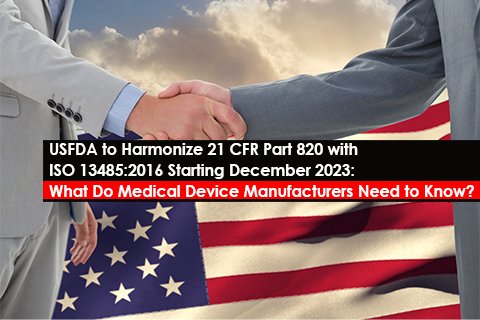The US Food and Drug Administration (USFDA) has proposed the harmonization of the 21 Code of Federal Regulations (CFR) Part 820 Quality System Regulation (QSR) for medical devices in accordance with the International Organization for Standardization (ISO) 13485:2016.
The proposed amendments aim at aligning the current requirements with the specifications outlined in ISO 13485:2016, an internationally recognized consensus for the medical device industry. Harmonizing different regulations would help do away with duplication of work to meet the Regulatory requirements, impediments to market access, and barriers to patient access and costs.
The Need for Harmonization
Harmonizing Regulatory systems across major global markets is crucial, as it facilitates compliance with international regulations. Recognizing the comprehensive and effective approach of ISO 13485:2016, the USFDA intends to align its regulations with it to minimize disparities and streamline processes for medical device organizations operating in multiple jurisdictions. By embracing harmonization efforts, such as establishing the Medical Device Single Audit Program (MDSAP) based on ISO 13485, the USFDA aims at enhancing Regulatory standardization and simplifying market access for medical device manufacturers.
Proposed Changes and Updates
- Definitions: The USFDA is planning to revise certain definitions in the current QSR to align with ISO 13485. This includes terms/phrases such as “management with executive responsibility,” “Device Master Record (DMR),” and “customer.” Some definitions that are unique to the USFDA will be retained, such as the definitions of terms like “manufacturer,” “product,” and “device.” Harmonizing definitions will help create consistency and eliminate confusion.
- Incorporation of ISO 13485: The USFDA will remove QSR provisions that are substantially similar to ISO 13485; they will instead directly reference the ISO. This approach will ensure that manufacturers comply with ISO 13485 requirements, promoting global harmonization and minimizing redundancies.
- Standardization of Quality System Requirements: Currently, medical device manufacturers in the US must comply with CFR 21 part 820. The proposed modification to the regulation aims at standardizing quality system requirements across regulations, highlighting compliance with USFDA requirements wherever discrepancies exist. This harmonization simplifies the compliance process for manufacturers operating in multiple jurisdictions.
- Clarification of Concepts: The USFDA intends to clarify the concepts of organization, safety, performance, and validation of processes with respect to ISO 13485 and the US Regulatory framework. This clarification will help manufacturers understand how ISO 13485 aligns with the statutory and Regulatory requirements in the US, ensuring compliance without confusion.
- Supplementary Provisions: The USFDA has plans to introduce additional requirements in the Quality Management System Regulation (QSMR) to ensure consistency and alignment with other US regulations and laws. These provisions will focus on areas such as record control and controls for labeling and packaging, providing a comprehensive Regulatory framework for manufacturers.
- Conforming Amendments: As part of the QMSR implementation, the USFDA will amend other parts of the CFR, such as part 4, to reflect the modifications made to part 820. This will ensure that all relevant regulations are updated consistently and prevent conflicts or inconsistencies in the Regulatory framework.
- Modernization of Risk Management: Risk management is a significant focal point in the QMSR, as it aligns with ISO 13485, which references ISO 14971, a standard that guides manufacturers in establishing effective risk management programs. The finalized QMSR will make ISO 14971 an enforceable element of the regulation, stressing the importance of robust risk management practices.
Impact on Medical Device Manufacturers
- Enhanced Risk Management: Manufacturers will have to prioritize proactive risk management by conducting comprehensive risk analysis to identify potential hazards and mitigate risks.
- Compliance Requirements: ISO 13485 certification will aid in USFDA compliance, but it will not exempt manufacturers from USFDA inspections solely based on ISO 13485.
- Streamlined Compliance Efforts: Harmonization reduces the need for separate Quality Management Systems (QMS), which in turn saves costs and streamlines processes for compliance with both USFDA requirements and ISO 13485.
- Improved Global Market Access: Aligning with ISO 13485 and using programs like MDSAP facilitates international market access by simplifying compliance with diverse Regulatory frameworks.
- Standardized Quality System Requirements: QSMR aims at standardizing quality system requirements across regulations, providing manufacturers with consistent guidelines for compliance and enhancing product quality and patient safety.
In conclusion, the USFDA’s proposed harmonization and modernization of the QSR for medical devices brings significant benefits to manufacturers. By aligning with the international standard ISO 13485, the USFDA aims at streamlining the Regulatory requirements, improving risk management practices, and enhancing global market access. The proposed changes, such as standardized quality system requirements and clarification of concepts, promote consistency and eliminate redundancies. Overall, these updates foster a more efficient Regulatory environment, ensuring the safety, quality, and accessibility of medical devices for patients worldwide.
Our team at Freyr has experience and expertise in end-to-end implementation of QMS for ISO 13485:2016 compliance. Our QMS services include:
- Identification of QMS Requirements
- Gap Analysis
- Remediation
- Implementation of QMS
- Internal Audit and Mock Audit Support
Schedule a free 30-minute call with our experts today to learn more about how we can help you set up a robust Quality Management System. Stay informed! Stay compliant!





